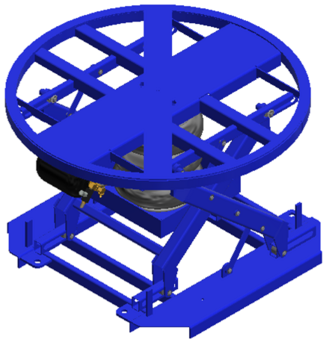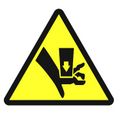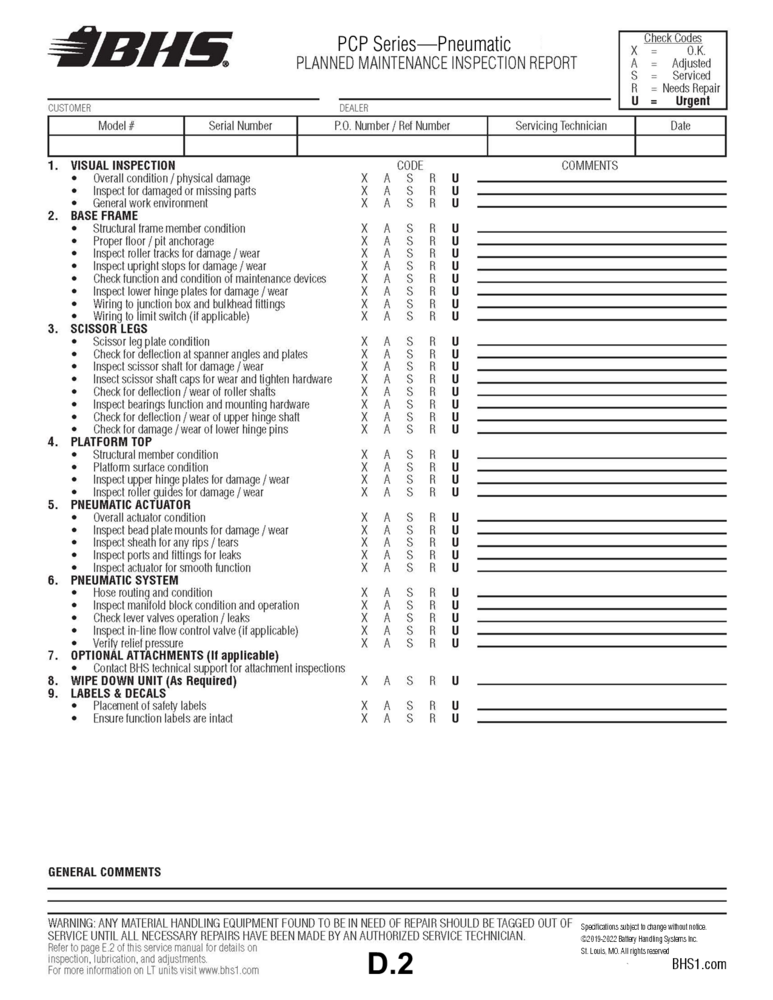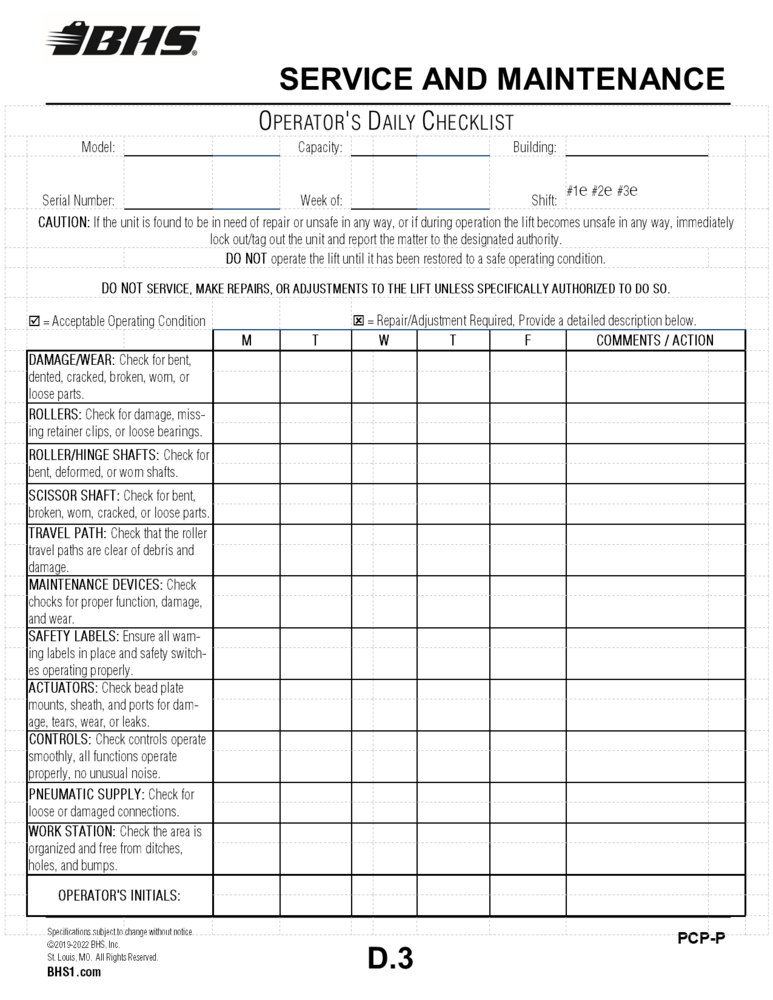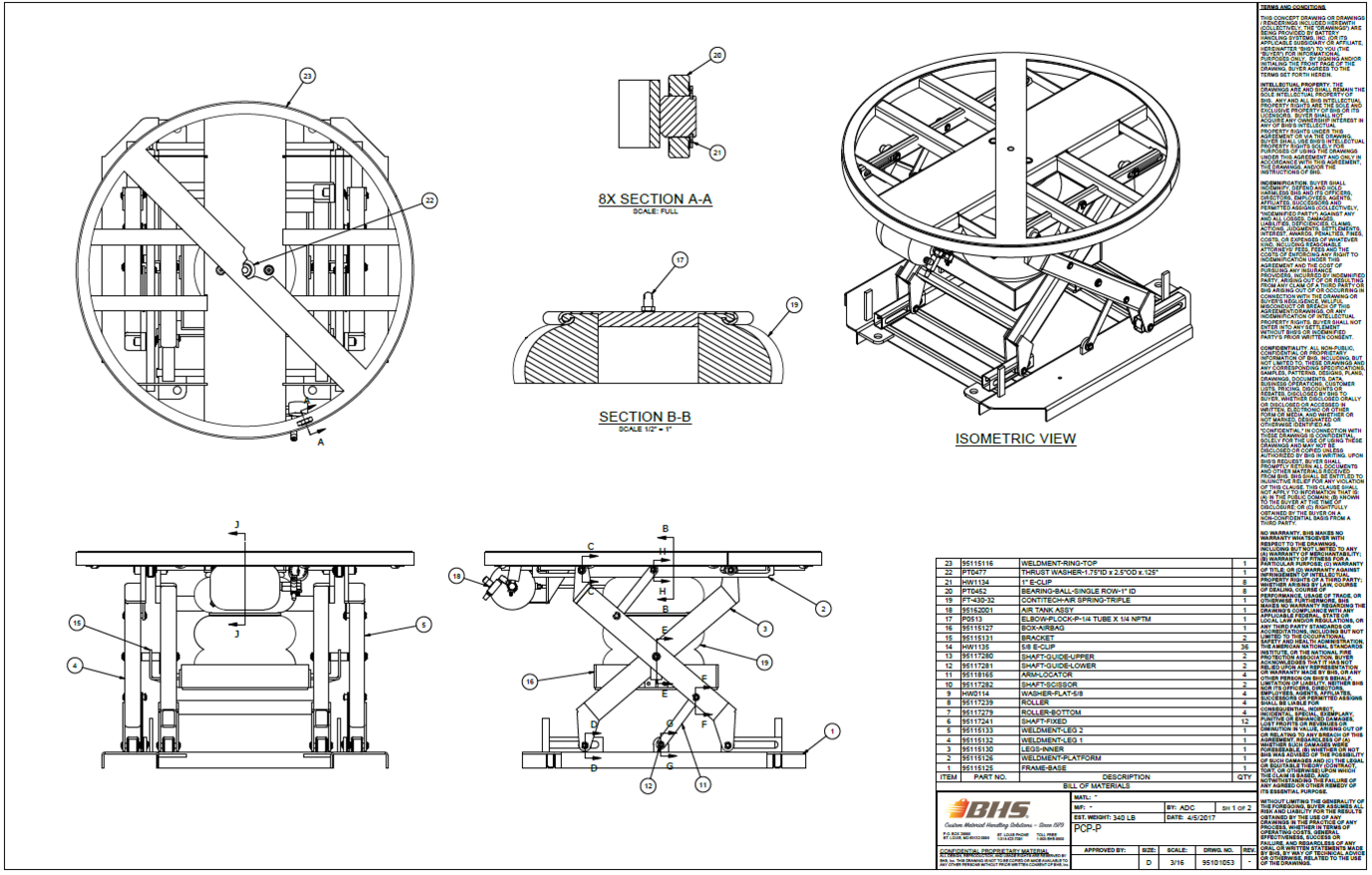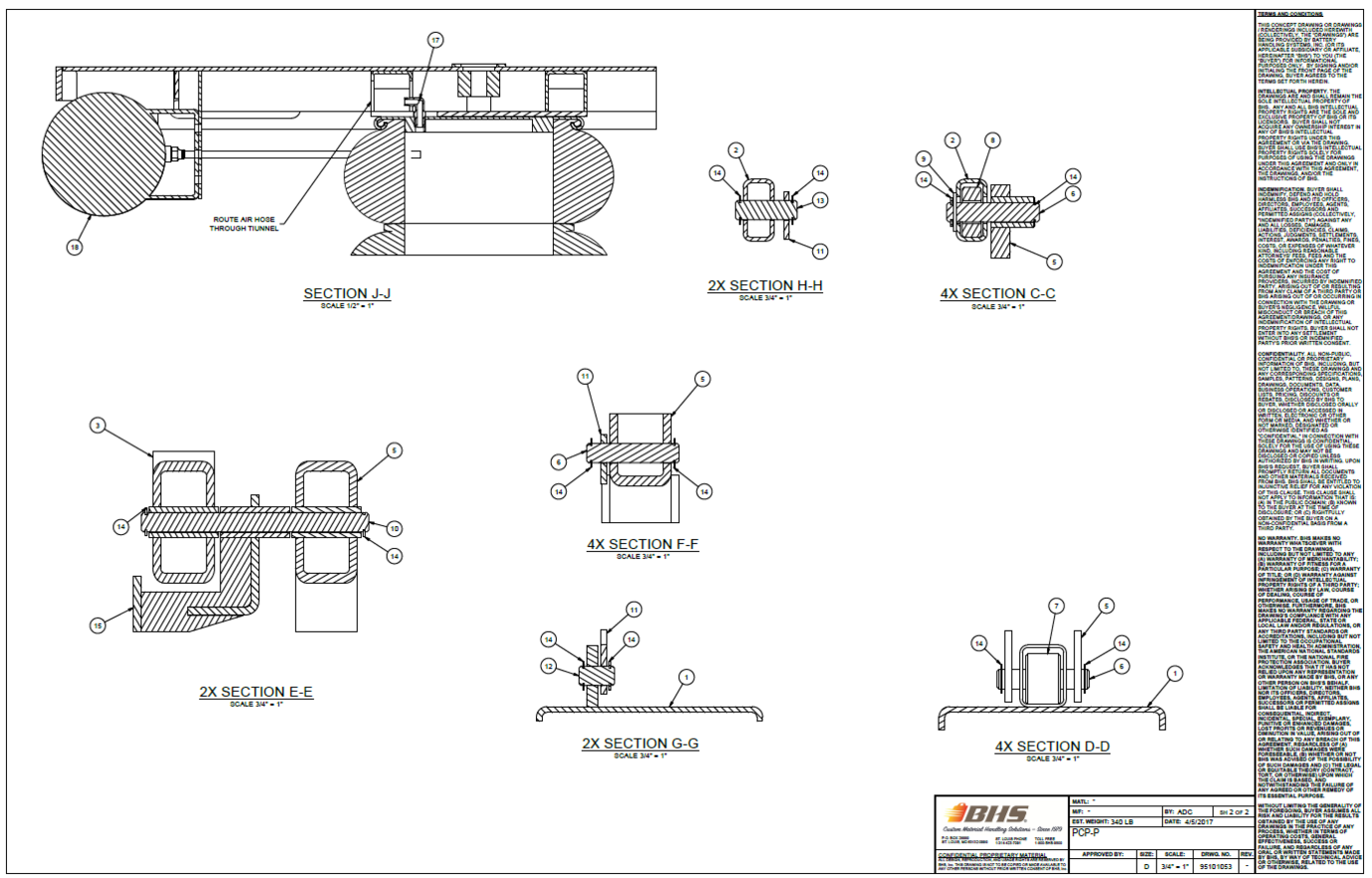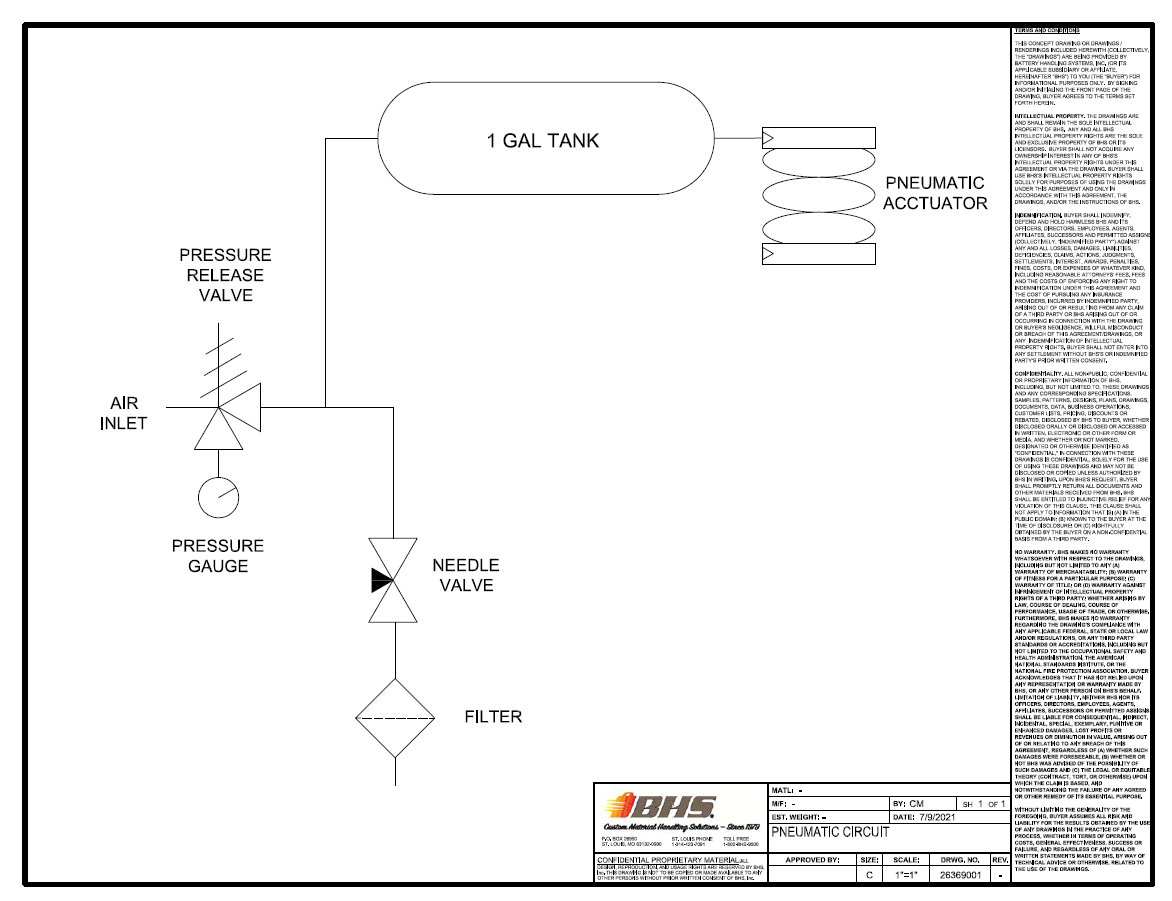IOP-PCP-P Manual
Looking for a specific replacement part? Ctrl-F (or Command-F for Mac users) brings up your browsers search panel and can search any text on the entire web page. Find parts by searching a part # or part description.
Register your equipment with BHS Optima, BHS's free app.
California Residents: WARNING: This product contains chemicals known to the State of California to cause cancer and/or reproductive harm, and birth defects or other reproductive harm. Learn more here.
Pallet Carousel & Positioner with Self-Leveling Pneumatic Airbag - Parts & Service Manual
GENRAL INFORMATION
Read and understand this manual before installation, use, and maintenance for your lift. Please be sure that no individual is allowed to use this lift unless they have been fully trained and familiarized with the operating instructions of this manual. Also, ensure that at least one person on site is familiar with the maintenance section of this manual and is responsible for performing the defined tasks. If you have any questions regarding operation, service, or the contents of this manual, please contact your dealer or BHS Technical Support 1.877.BHS.4YOU (1.877.247.4968) or visit tech.bhs1.com.
PCP units vertically position materials at comfortable heights for improved ergonomics and productivity. The Series is designed to reduce physical strain, fatigue, and prevent injury by eliminating heavy lifting, bending, and reaching. Scissor Lift Tables are available in many standard sizes and capacities to lift and position loads. Please consult a dealer or sales representative for application specific needs.
GENERAL SAFETY
- Read and understand all instructions and warnings before using or servicing this equipment
- Keep these instructions for future reference.
- PCP units shall only be used indoors in an industrial setting on a hard, nonslip, and level floor without irregularities including but not limited to holes, gouges, cracks, drains or obstacle comprised of concrete or other suitable industrial material.
- Forces required to operate the unit vary with weight of the load, floor conditions, and unit conditions.
- Stationary units are designed to only be operated when securely mounted to the floor using approved hardware.
- A licensed structural engineer should be consulted prior to installing an unit on any building level other than the ground floor.
- Perform system and safety checks before operating.
- Failure to follow these instructions and warnings may result in property damage, personal injury or death.
WORK AREA
- Keep work area clean and well lit. Cluttered work areas and poor lighting can lead to accidents.
- Clean up/contain any fluid spills immediately to prevent slips or falls.
- Be aware of potential hazards when performing any service or maintenance to the unit.
SERVICE & MAINTENANCE
Service personnel shall wear Personal Protective Equipment (PPE) appropriate for the task being performed. Deploy maintenance chocks before performing any repairs or maintenance on the unit.
LOCKOUT/TAGOUT
Lockout/tagout the unit if damaged or not functioning properly. Lockout/tagout and de-energize all systems prior to performing any maintenance or service to unit(s).
AVOID HIGH PRESSURE AIR
High pressure, compressed air can dislodge particles that can enter the eyes or abrade skin. Hearing can be damaged by the sound of escaping high pressure, compressed air. Relieve pressure before disconnecting air lines. Tighten all connections before applying pressure. Keep hands and body away from holes which eject air under high pressure. High pressure, compressed air can enter the blood stream through a break in the skin or through a body opening. An air bubble in the blood stream is know as an “embolism”, a dangerous medical condition in which a blood vessel is blocked by the air bubble. An embolism of an artery can cause coma, paralysis or death depending upon its size, duration and location. A small quantity of air (or other gas) in the blood can quickly become fatal.
INSTALLATION
INSTALLATION NOTES
Prior to installation of the unit, unpack and remove all shipping materials. A visual inspection should be conducted to check for missing parts or damage occurred during transit.
Failure to follow proper safety procedures will result in serious personal injury or death.
- Refer to Section D “Service & Maintenance”
- Clear the installation area and inspect the installation surface using a level or straight edge.
- Place the unit in the installation area using an approved method such as a forklift below the base frame.
Failure to support the base frame when transporting the unit can result in personal injury, death and/or property damage.
Do not pressurize the PCP over 95 PSI
The unit was designed to handle a wide range of load capacities at different air pressures. PSI should be adjusted depending on the load or desired height.
- Pressurize unloaded unit to a max of 95 PSI.
- Place load on the unit.
- Adjust the pressure until the desired height is achieved.
- Continually adjust the pressure as you work to maintain the desired height as the load changes.
Filtered and Dry air supply is recommended but not required.
OPERATING INSTRUCTIONS
The following instructions will guide you through the basic steps necessary to properly and safely operate this unit. Before using this unit, the operator should:
- Read and understand this manual and the operating instructions.
- Be thoroughly trained on the use and safety of this lift.
- Inspect for proper operating conditions and safety devices.
- Check for and eliminate any obstructions in the travel path.
- Inspect all pneumatic connections to ensure they are complete and operational.
KEEP HANDS, ARMS,FEET, LEGS, HAIR, AND JEWELRY OUT OF THE SCISSOR LEGS AND TRAVEL PATH WHILE THE UNIT IS OPERATING.
OPERATIONAL TEST
After the initial installation has been completed, or any service to the unit has been performed, an operational test should be conducted to ensure proper operation of the unit.
LOADING THE PLATFORM
The load capacity rating is stated on capacity labels throughout the unit. The capacity rating is the maximum load for a standard unit model with a standard platform top. Modifications and additions to this unit shall not be made without prior written consent from the manufacturer. Where special tops, attachments, etc. are installed on the lift after shipment, deduct the weight of these from the load capacity rating to obtain the new maximum capacity.
- NEVER EXCEED THE LOAD CAPACITY RATING. Overloading the lift will result in severe personal injury or death, cause structural damage to the lift, shorten the life of the lift, and void the unit’s warranty.
- NEVER OFFSET THE LOAD. The upper rollers are not captured. Do not overhang a load on the hinged end of the platform that would cause the roller end to tip up, dumping the load and causing severe personal injury or death.
- ALWAYS BALANCE & CENTER THE LOAD. Balanced and centered loads will promote the longest life of the unit and ensure even wear on all moving parts.
- ALWAYS SECURE THE LOAD. A balanced and secure load is the safest means of lifting the load.
- Lower the platform to the fully lowered position by turning the valve and releasing the air.
- Transport the load to the lift platform.
- Center, balance, stabilize, and secure the load.
- With the load properly positioned and secured, the platform can be raised to the desired height by closing the pneumatic valve and increasing the pressure relative to the load.
OPERATIONAL SAFETY
OPERATIONAL SAFETY
- Only personnel trained in the proper and safe operation of units may operate or service the PCP.
- All data plates, warning labels, placards, etc. shall be in place and legible at all times. Contact BHS for replacement data plates, warning labels, placards or instructions.
- All users and service personnel shall be familiar with the meaning, significance, and risks associated with all data plates, warning labels, etc.
- All operators and service personnel shall be aware of potential crush and shear points while operating or servicing the unit.
- Units shall be operated in an area with ambient light levels of at least 50 lux.
- Keep hands, arms, feet, legs, hair, and jewelry out of the scissor legs or travel path while operating the unit.
- Engage the maintenance chocks and properly secure the unit prior to transporting the unit to a new location.
- Avoid abrupt changes in elevation when operating a unit to prevent loss of the load and/or loss of control of the unit.
- Remove the unit from service if damaged or operating improperly (or becomes such while operating) until repairs can be made to correct any problem(s).
DO'S AND DONT'S
- DO NOT exceed the maximum capacity of the unit.
- DO NOT modify or fit the unit with attachments without prior, written approval from BHS.
- DO NOT perform any maintenance or service to the unit with a load on the platform.
- Deploy maintenance chocks prior to transporting or relocating the unit.
- DO NOT service the unit without proper use of provided maintenance chocks.
- DO NOT use the unit in a manner for which it is not intended. Some examples of prohibited use are but not limited to:
- As a vehicle jack
- To lift loads greater than its rated load capacity
- Where unintentional movement may occur
- Having direct contact with foodstuffs
- In a potentially explosive atmosphere
- On an uneven floor or surface
SERVICE & MAINTENANCE
The following are the basic practices necessary to properly, and safely, service and maintain this unit. It is recommended that a routine maintenance program be enforced to prolong the life of the unit and prevent costly repairs or downtime. Before servicing this unit, the operator should:
- Read and understand “SERVICE AND MAINTINANCE” instructions.
- Read and understand this manual and the service and maintenance instructions.
- Understand mechanical devices and their associated pneumatic.
- Be thoroughly trained on the use and safety of this unit.
SAFE SERVICE PRACTICES
Failure to follow proper safety procedures can result in serious personal injury or death.
- Inspect the lift in regular intervals: daily, weekly, monthly, and yearly. See pages D.2, D.3, D.4 of this manual.
- DO NOT ignore a unit in need of repair. A unit in disrepair can be a severe hazard to persons and/or property when left unattended.
- Use only BHS approved replacement parts.
- Observe and identify all potential hazards prior to servicing the unit.
- NEVER apply a load to the platform unless the base frame is continuously supported and properly anchored.
PLANNED MAINTENANCE INSPECTION REPORT
OPERATOR'S DAILY CHECKLIST
SAFTEY & WARNING LABELS
| ITEM | BHS PART NUMBER | DESCRIPTION | REF. KIT NO. | NOTES | NO. REQ. |
|---|---|---|---|---|---|
| 1 | DECAL | DECAL-BHS-ANNIVERSARY | - | - | 1 |
| 2 | 00196709 | Label_Crush Hazard_2" | - | - | 2 |
| 3 | 00196701 | Label_Capacity 4500# | - | - | 2 |
| 4 | 00196424 | Label_Warning List PCP-S | - | - | 2 |
| 5 | HW1102 | Decal_BHS_4.5" x 1.5" | - | - | 2 |
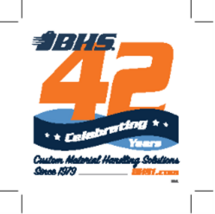
1 |
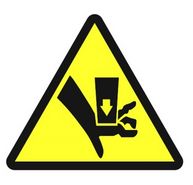
2 |
|---|---|
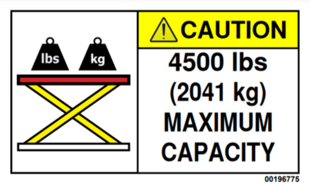
3 |
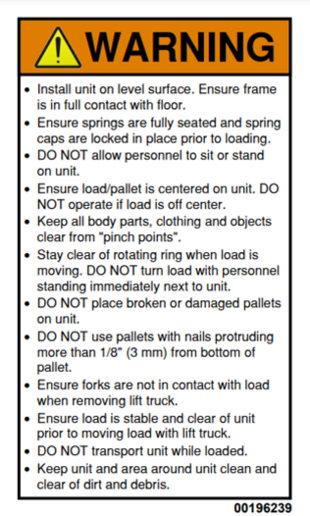
4 |
PARTS SECTIONS
CHASSIS
PNEUMATICS
STATEMENT OF WARRANTY
Statement of Warranty
Click here for details on BHS' Statement of Warranty.
